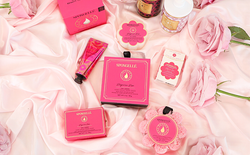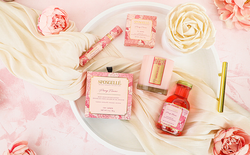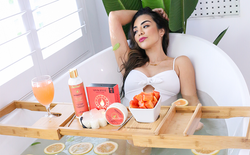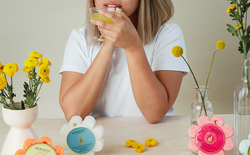Searching for the perfect perfume can be quite a task. You may be testing different samples or looking through magazines for scent strips, but have you ever thought about making your own fragrance?
DIY perfume is easier than you think, even though it may seem as equally challenging as finding a fragrance already on the market. Making your perfume will give you complete control, and it will be truly your own signature scent. Plus, you can avoid harsh chemicals that you can find in some fragrances.
Once you know how to build a fragrance and what type of ingredients to look for, you'll be excited to start experimenting. We have a complete step-by-step guide on how to make perfume from the comfort of your home.
How To Create a Scent
First, it's important to understand the layers of a fragrance and how they’re created. The basic composition of a scent is top notes, middle notes, and base notes.
Top notes are the first ingredients you smell, but they only last a little while. First impressions are important and picking something light, and fresh can do the trick. Think citrus fruit and spices like grapefruit, orange, or bergamot.
Your middle notes will be what you smell when the top notes wear off. They last longer than the initial notes and give the fragrance character. Common ingredients are floral scents like jasmine, gardenia, and lotus. You can also use rosemary or vetiver. These scents will linger on the skin for a few hours.
The base notes are the foundation of the fragrance and, thus, the last ingredients you will smell. You may be able to smell them on your skin or clothing for days. These ingredients boost the top and middle notes and are often rich, heavier scents. Try combining things like cedarwood and amber to create a natural perfume.
Perfume Blends To Try
Now that you know the basics of building a fragrance, consider what perfume blends you want to try. You can find inspiration from high-quality products already on the market, like Spongellé's Private Reserve Eau De Toilette collection.
For example, our Black Orchid scent uses bergamot, juicy mandarin, and orchid petals for top notes and jasmine, black gardenia, and a lotus flower for middle notes. The base notes are ylang-ylang, sandalwood, patchouli, and vanilla. You may like some of these scents, but maybe you want to use peony instead of gardenia. This process is about making it your own!
You probably have a fragrance accord that you already gravitate towards, whether it's floral, citrus, spice, or woodsy. In perfumery, there are standard fragrance blends to create these popular scents. Citrusy scents almost always rely on essential oils of lemon, orange, mandarin, or grapefruit. They don't have too many middle or base notes but adding an ingredient like jasmine can give the perfume some complexity and prolong the olfactory experience.
Choose Your Carrier and Oils
The other ingredient you have to consider is what you will use as a carrier in your perfume. The carrier is a scentless base that will "carry" your chosen fragrances. It also will help protect your skin and dilute the scents. You generally don't want to apply the perfume essential oils or fragrance oils directly to your skin, and a carrier agent is the best solution.
There are plenty of carrier agents you can pick. People use alcohol, oils, and even waxes to produce perfumes. However, the agent you use will give you completely different results.
Oil was the original base for the first perfumes used by Greek and Roman people. If you opt for a carrier oil, like Jojoba oil or almond oil. Jojoba oil is a great option since it is light and similar to the natural oils your skin already produces. It also absorbs quickly and won't leave your skin feeling greasy or with a residue.
The other option is using perfumers alcohol as a carrier agent. It can give the fragrance longevity and is one of the most popular options. When you use alcohol, you can spritz the perfume anywhere like you would store-bought products. Use alcohol that is 200 proof because it's ideal for perfumes, eau de parfum, eau de toilette, and cologne.
Think About Your Skin Type
The choice is up to you, but if you have sensitive skin, consider using an oil. Alcohol can be drying on the skin and can bother some skin types. You can also use both oil and alcohol to create your own custom blend.
The other ingredients you must select are essential or fragrance oils for your scents. Essential oils are a more natural ingredient and can have aroma-therapeutic properties. They generally smell better, and certain scents are reasonably affordable. Meanwhile, fragrance oils don't have the same benefits but are generally less expensive.
If you choose fragrance oil, look for products labeled fragrance notes. These oils have been synthesized for perfumery. You can also try using some raw materials by pressing flower petals and other plant materials.
Gather Ingredients and Supplies
We're getting closer to your first homemade perfume. It's time to gather all of your perfume ingredients and supplies. Make sure you have all of your fragrances and your carrier agent.
You'll also need a dark glass bottle to hold your new perfume. You don't want to use clear glass because light can negatively affect the perfume oils. You'll want to keep it in a dark place, away from visible light, heat, and air. These things can cause your fragrance to lose its scent or even make it smell bad.
Here's a list of what you'll need:
- Carrier oil (JoJoba oil, sweet almond, or anything you prefer)
- Alcohol (If you're using both oil and alcohol)
- Purified water
- Essential or fragrance oils of the scents you chose
- A small funnel
- Coffee filter
- Dark glass bottles with airtight lids
Make Your Own Perfume
Perfume making is pretty simple once you have everything ready. You just need to combine all of the ingredients by following a perfume recipe.
Recipe:
- Two tablespoons carrier oil
- Six tablespoons of alcohol
- 2.5 tablespoons of water
- 30 drops of essential or fragrance oil (nine drops for top notes, 15 drops for middle notes, and six drops for base notes)
Start by measuring out your carrier agents. Next, add in your base notes first, followed by middle notes, and then top notes. The recipe is a suggestion. You can decide how much of each fragrance to add fragrance based on your preferences. However, the general ratio is 80% carrier agents and 20% oils.
The first time you make your own perfume, you can start with a few drops and add as you go. It's easier to add more than it is to remove ingredients. You can dip a piece of paper into the mixture and smell it after you add each ingredient. If you think it needs more of a certain scent, you can add a few more drops.
After everything but the water has been combined, secure the lid of your glass bottle. You'll want to place your perfume in a dark place and let it sit for at least 48 hours. The longer you let the perfume rest, the stronger the scent will be.
Once you like the strength of the fragrance, add the water and shake the bottle for at least a minute. Next, place the coffee filter into the funnel and pour the perfume into the new bottle. Congrats, you've just made your very own signature scent!
How To Apply Your Perfume
The way you apply your perfume will depend on the bottle. However, whether it's in a spray bottle, roller ball, or solid perfume, the places you use it will be the same.
You want to apply your perfume to your pulse points. These areas are where the veins are closest to the surface of your skin. Think about where you can feel your pulse, like your wrists, behind your ears, inner elbows, belly button, and behind your knees.
These areas work well for perfume application because your body heat will help diffuse the fragrance. Dab the perfume over these pulse points, but don't rub it into your skin. Rubbing in your perfume will make the top notes evaporate almost immediately, and the friction can even alter the scent. Instead, allow the perfume to mix with your skin and develop naturally.
Hot tip, apply your perfume after you get out of the shower and moisturize your body. Hydrated skin is the best foundation for perfume. The body lotion will give the perfume something to cling to, and it will last longer. Try one of Spongellé's body lotions before your next perfume application.
Our body lotion is formulated with a combination of shea butter, jojoba oil, and vitamin E. It will nourish your skin and make it softer and smoother.
Final Takeaways
Making your own perfume is somewhat of an art form. You're creating unique blends that are customized to you. Don't be scared about experimenting with ingredients to find what you like best. Test them on your skin before adding them to your perfume. Spongellé has scents to help you get inspiration for your homemade perfume.
Sources:
The History of Perfume | By Arcadia















